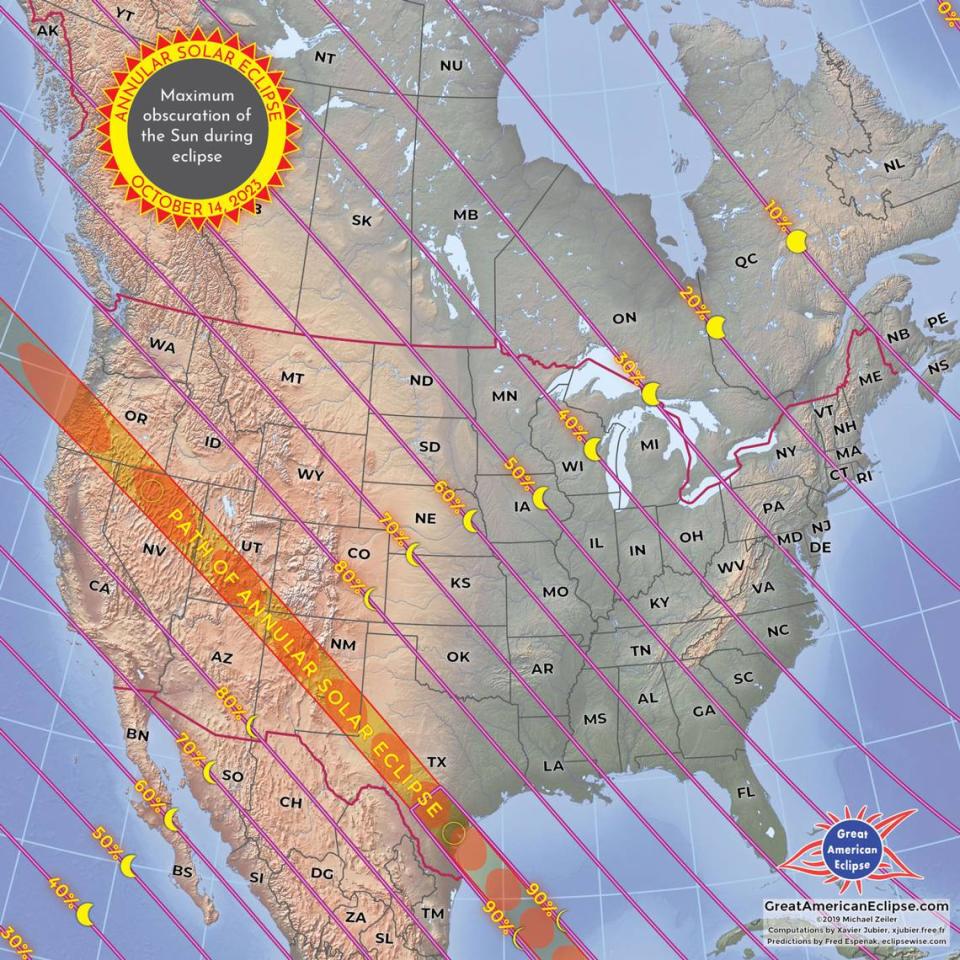October solar eclipse to darken Texas skies. Here’s what to know about historic event
It’s nearly time for the Texas sky to go partially dark.
The annular solar eclipse, which can be seen mainly from North and South America, occurs in just over a week on Oct. 14. Luckily for Texans, the path of the eclipse runs right through the Lone Star State.
Here’s what we know about the solar eclipse and when Texans can take a peek:

What is a solar eclipse?
A annular solar eclipse happens when the moon passes between the sun and Earth, while at its farthest point from the Earth, according to NASA.
Since the moon is farther away from the Earth, it looks smaller than the sun and thus doesn’t cover the star. That’s what makes the this an annular or “ring of fire” eclipse, instead of a total eclipse which leaves the sky completely dark.
Can you look directly at the solar eclipse?
No, at least not with the naked eye.
Viewing any part of the solar eclipse can cause severe eye injury due to the nature of the sun’s brightness, according to NASA. If someone was to view the solar eclipse with the naked eye, camera lens, binoculars or even a telescope, they would sustain severe orbital injuries.
And don’t think regular sunglasses will do the trick, because they won’t. The only way to view the solar eclipse are with “eclipse glasses” or a handheld solar viewer.
People can purchase “eclipse glasses” here or make their own solar viewer at home.
The solar viewer is made by taking a cardboard box and putting a piece of white paper on the back inside wall, then making a pinhole on the other side of the box so light can pass through the hole and onto the paper. For more instructions from NASA on making the solar viewer, visit here.

What time is best to see the solar eclipse in Texas?
For Fort Worth, about 11:52 a.m. on eclipse day.
The solar eclipse will be first viewable in the northwestern part of the United States in Oregon just after 9 a.m. on Oct. 14. The path will continue moving south across several western states such as Utah, Nevada and New Mexico.
El Paso will be the first Texas city to have a good view of the solar eclipse at about 10:40 a.m., according to National Eclipse. The rest of the Lone Star State will follow:
Lubbock- 11:44 a.m.
Fort Worth- 11:52 a.m.
Dallas- 11:52 a.m.
Austin- 11:54 a.m.
Laredo- 11:55 a.m.
Houston- 11:58 a.m.
Texans will need to be ready if they want to view the solar eclipse, because it could be over in mere minutes.
When is the next solar eclipse?
Texans won’t have to wait long for the next solar eclipse.
On April 8, 2024, a total solar eclipse will cross over North America. However, this will be a total solar eclipse, meaning that the moon will pass between the sun and Earth, completely blocking the sun and leaving the sky completely dark like it would be at dawn or dusk, according to NASA.


